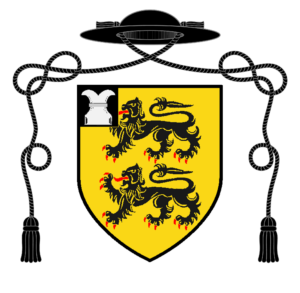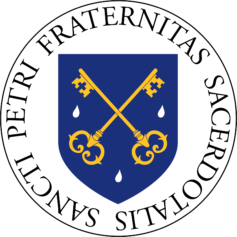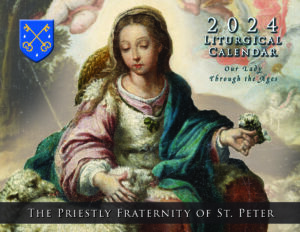Christ the Lamb
by Fr. William Rock, FSSP
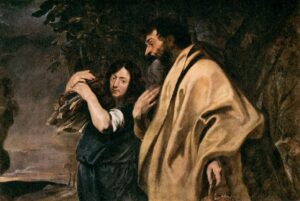
During the Easter Season, Our Lord as the Lamb (Agnus in Latin) takes a predominate place in the Church’s liturgy. In the Preface of Paschaltide, the Church sings: “Christ our Pasch [Passover Lamb] was sacrificed. For He is the true Lamb Who hath taken away the sins of the world (Pascha nostrum immolátus est Christus. Ipse enim verus est Agnus, qui ábstulit peccáta mundi).” During the Easter Octave, in the Sequence, the following is chanted: “Christians! to the Paschal Victim offer your thankful praises. The Lamb the sheep redeemeth (Víctimæ pascháli laudes ímmolent Christiáni. Agnus rédemit oves).” At Vespers of the Season, the Church hymns about the “Lamb’s high feast (Ad régias Agni dapes)” and Christ the Paschal Lamb (“Iam Pascha nóstrum Christus est“) who was sacrificed. The phrase “Christ our Pasch [Passover Lamb] is immolated (Pascha nostrum immolátus est Christus)” is found both in the Epistle and Communion of the Easter Sunday Mass (1 Cor 5:7).
Of course, it is not only during the Easter Season that Our Lord is presented as the Lamb. In the Gloria, He is invoked as the “Lamb of God” (Agnus Dei). After the commixtio of the particle broken from the Host and the consecrated Wine, the Church asks for mercy and peace from the “Lamb of God” (Agnus Dei). When Holy Communion is distributed, He is presented to the faithful as the “Lamb of God” (Ecce Agnus Dei). However, during the Easter Season, Our Lord as the Lamb is given, as was said above, a predominate place.
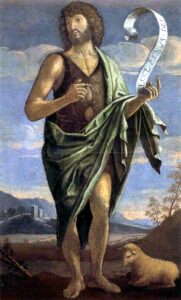
Referring to Christ as Lamb has its foundation in Sacred Scripture. At the banks of the Jordan River, St. John the Baptist pointed out Our Lord with the words: “Behold the Lamb of God. Behold him who taketh away the sin of the world” (Joh 1:29). This harkens back to the first book of the Old Testament. When Abraham and his son Isaac were making their way to the place of sacrifice appointed by God, Isaac asked his father (Gen 22:7), “Behold, saith he, fire and wood: where is the victim for the holocaust?” His father prophesied, “God will provide himself a victim for an holocaust” (Gen 22:8). The word translated here as “victim” is, in the Greek Septuagint, πρόβατον,1 which more specifically means “sheep.” The Hebrew is השׂה, “ewe, lamb, sheep.”2 An angel stops Abraham before he sacrifices his son and, in his place, they offer a ram (Gen 22:13). Centuries will pass until Abraham’s prophesied Lamb will be provided and sacrificed.
Our Lord symbolized as Lamb is found as well in the last book of Holy Scripture, where St. John the Apostle wrote that he saw in his vision “a Lamb standing, as it were slain, having seven horns and seven eyes: which are the seven Spirits of God, sent forth into all the earth…the Lamb which was slain from the beginning of the world…worthy to receive power and divinity and wisdom and strength and honour and glory and benediction” (Apo 5:6, 13:8, 5:12). He also tells of the “the wrath of the Lamb” (Apo 6:16) which will fall upon sinners.
But the question naturally arises, why is the lamb a fitting symbol of Our Lord? Now a lamb is a young sheep. As St. Thomas Aquinas, quoting an earlier work, wrote, a sheep is useful in four ways: “for sacrifice, for meat, for milk, and for its wool” (S.T. I-II, q. 105, a. 2, ad 9). How each of these can be applied to Christ will be treated in turn.
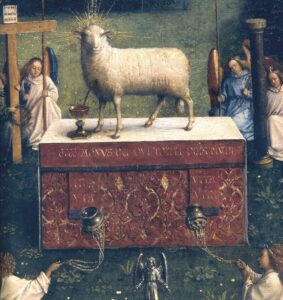
For Sacrifice. The lamb was a common sacrificial victim under the Old Law (e.g., Exo 29:39-41). Particularly, the sacrifice of lambs was the principal daily sacrifice. Every day, a lamb was to be offered in the morning and in the evening. The sacrifice of a lamb was also an essential feature of the Passover ceremony (see Exo 12:1-28). In His self-sacrifice upon the Cross (Heb 9:14, Isa 53:7), Christ is compared to a lamb – “He was led as a sheep to the slaughter: and like a lamb without voice before his shearer, so openeth he not his mouth” (Act 8:32, see Isa 53:7); “knowing that you were not redeemed with corruptible things…but with the precious blood of Christ, as of a lamb unspotted and undefiled” (1 Pet 1:8-19). As the sacrifice on the Cross is the principal and essential sacrifice of all sacrifices, it is fitting, in this respect, that Christ is represented as a lamb.3
For Meat. In general, sheep, and thus lamb, can be used for food. In the Old Law, the eating of lamb took on a religious significance in the consumption of the Passover Lamb. Our Lord, in the midst of a Passover celebration, gave His Body, under the appearance of Bread, to His Disciples to be eaten. Until His Second Coming, Our Lord continues to feed His faithful with His Body in Holy Communion.
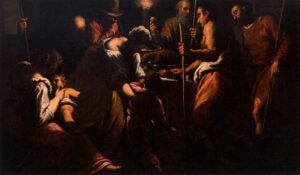
For Wool. The coats of sheep and lambs can be shorn and used for wool. This wool is then used to make clothing and other textile products. By clothing oneself with wool, one is, after a fashion, clothing oneself with the lamb from which the wool came. When one is sanctified by the grace merited by Christ on the Cross, it can be said that one is symbolically being clothed by grace and thus by the one Who merited it. This concept is expressed by the Holy Ghost through the Apostle Paul in his writings – “put ye on the Lord Jesus Christ: and make not provision for the flesh in its concupiscences” (Rom 13:14), “for as many of you as have been baptized in Christ have put on Christ” (Gal 3:27). But, it is important to note, that this language is symbolic. When one is sanctified, there is an intrinsic, that is an internal, real yet supernatural change in one’s soul. Putting on clothing is an extrinsic, or external, change.
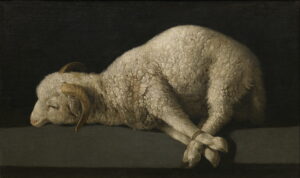
For Milk. While only mature female sheep produce milk, this, after a fashion, can still be attributed to Our Lord. According to St. Peter, milk (rationale/rationabiles lac) can be seen as symbolic of heavenly doctrine (1 Pet 2:2, the Introit for Low Sunday).4 Heavenly doctrine, of course, was preached par excellence by Our Lord. It could also be said that just as milk, a nourishing drink, flows from the sheep, so did a spiritual drink flow from Our Lord’s Heart opened on the Cross, which drink, His very Blood, is received under the appearance of Wine.
But the above does not exhaust the symbolic value of a lamb representing Christ. In his commentary on the Gospel of John (n. 258), St. Thomas, in explaining why Our Lord is called the Lamb of God by John, wrote the following:
Christ is called a lamb, first, because of his purity: your lamb will be without blemish (Exod 12:5); you were not redeemed by perishable gold or silver (1 Pet 1:18). Second, because of his gentleness: like a lamb before the shearer, he will not open his mouth (Isa 53:7). Third, because of his fruit; both with respect to what we put on: lambs will be your clothing (Prov 27:26), put on the Lord Jesus Christ (Rom 13:14); and with respect to food: my flesh for the life of the world (John 6:52). And it is said: send forth, O Lord, the lamb, the ruler of the earth (Isa 16:1).
In answer to the question posed above, there are many reasons why it is fitting that Our Lord is symbolized by a Lamb, both in Sacred Scripture and in the Church’s Liturgy, for this representation brings to mind sacrifice, meat, wool, milk, purity, gentleness (and, yet, also wrath at the proper time). By reflecting on these, the faithful can better understand this Lamb Who sacrificed Himself for them, His sheep, especially during the Paschal Season.
Fr. William Rock, FSSP was ordained in the fall of 2019 and is currently assigned to Regina Caeli Parish in Houston, TX.
In support of the causes of Blessed Maria Cristina, Queen, and Servant of God Francesco II, King
- Strong, G4263.
- Strong, H7716.
- See also St. Thomas’ Commentary on John, n. 257.
- See Guéranger, Prosper. The Liturgical Year, 7 (Paschal Time Book I). Trans. Shepherd, Laurence. (Fitzwilliam: Loreto Publications, 2000), p. 300.
April 19, 2024


